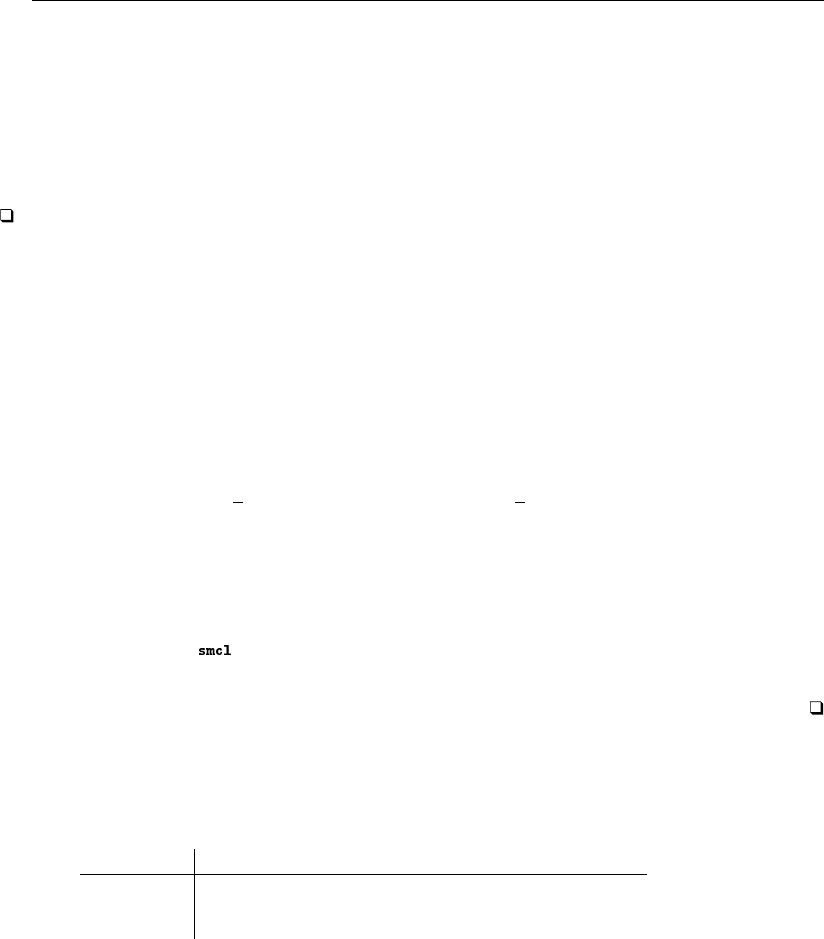
Title stata.com
display — Display strings and values of scalar expressions
Description Syntax Remarks and examples Also see
Description
display displays strings and values of scalar expressions. display produces output from the
programs that you write.
Interactively, display can be used as a substitute for a hand calculator; see [R] display. You can
type things such as display 2+2.
Syntax
display
display directive
display directive
. . .
where display directive is
"double-quoted string"
‘"compound double-quoted string"’
% fmt
=
exp
as
text | txt | result | error | input
in smcl
asis
skip(#)
column(#)
newline
(#)
continue
dup(#)
request(macname)
char(#)
,
,,
1

2 display — Display strings and values of scalar expressions
Remarks and examples stata.com
Remarks are presented under the following headings:
Introduction
Styles
display used with quietly and noisily
Columns
display and SMCL
Displaying variable names
Obtaining input from the terminal
Introduction
Interactively, display can be used as a substitute for a hand calculator; see [R] display. You can
type things such as display 2+2.
display’s display
directives are used in do-files and programs to produce formatted output. The
directives are
"double-quoted string" displays the string without the quotes
‘"compound double-quoted string"’ displays the string without the outer quotes;
allows embedded quotes
% fmt
=
exp allows results to be formatted;
see [U] 12.5 Formats: Controlling how data are displayed
as style sets the style (“color”) for the directives that follow;
there may be more than one as style per display
in smcl switches from asis mode to smcl mode
asis switches from smcl mode to asis mode
skip(#) skips # columns
column(#) skips to the #th column
newline goes to a new line
newline(#) skips # lines
continue suppresses automatic newline at end of display command
dup(#) repeats the next directive # times
request(macname) accepts input from the console and places
it into the macro macname
char(#) displays the character for ASCII and extended ASCII code #,
where # > 127 is treated as a Latin1-encoded character
and will be converted to the corresponding UTF-8 character
, displays one blank between two directives
,, places no blanks between two directives

display — Display strings and values of scalar expressions 3
Example 1
Here is a nonsense program called silly that illustrates the directives:
. program list silly
silly:
1. set obs 10
2. gen myvar=runiform()
3. di as text _dup(59) "-"
4. di "hello, world"
5. di %
~
59s "This is centered"
6. di "myvar[1] = " as result myvar[1]
7. di _col(10) "myvar[1] = " myvar[1] _skip(10) "myvar[2] = " myvar[2]
8. di "myvar[1]/myvar[2] = " %5.4f myvar[1]/myvar[2]
9. di "This" _newline _col(5) "That" _newline _col(10) "What"
10. di ‘"She said, "Hello""’
11. di substr("abcI can do string expressionsXYZ",4,27)
12. di _char(65) _char(83) _char(67) _char(73) _char(73)
13. di _dup(59) "-" " (good-bye)"
Here is the result of running it:
. silly
Number of observations ( ) was 0, now 10
-----------------------------------------------------------
hello, world
This is centered
myvar[1] = .13698408
myvar[1] = .13698408 myvar[2] = .64322066
myvar[1]/myvar[2] = 0.2130
This
That
What
She said, "Hello"
I can do string expressions
ASCII
----------------------------------------------------------- (good-bye)
Styles
Stata has four styles: text (synonym txt), result, error, and input. Typically, these styles
are rendered in terms of color,
text = black
result = black and bold
error = red
input = black and bold
or, at least, that is the default in the Results window when the window has a white background. On
a black background, the defaults are
text = green
result = yellow
error = red
input = white

4 display — Display strings and values of scalar expressions
In any case, users can reset the styles by selecting Edit > Preferences > General Preferences in
Windows or Unix(GUI) or by selecting Preferences > General Preferences in Mac.
The display directives as text, as result, as error, and as input allow you, the programmer,
to specify in which rendition subsequent items in the display statement are to be displayed. So if
a piece of your program reads
quietly summarize mpg
display as text "mean of mpg = " as result r(mean)
what might be displayed is
mean of mpg =
where, above, our use of boldface for the 21.432432 is to emphasize that it would be displayed
differently from the “mean of mpg =” part. In the Results window, if we had a black background,
the “mean of mpg =” part would be in green and the 21.432432 would be in yellow.
You can switch back and forth among styles within a display statement and between display
statements. Here is how we recommend using the styles:
as result should be used to display things that depend on the data being used. For statistical output,
think of what would happen if the names of the dataset remained the same but all the data changed.
Clearly, calculated results would change. That is what should be displayed as result.
as text should be used to display the text around the results. Again think of the experiment where
you change the data but not the names. Anything that would not change should be displayed as
text. This will include not just the names but also table lines and borders, variable labels, etc.
as error should be reserved for displaying error messages. as error is special in that it not only
displays the message as an error (probably meaning that the message is displayed in red) but also
forces the message to display, even if output is being suppressed. (There are two commands for
suppressing output: quietly and capture. quietly will not suppress as error messages but
capture will, the idea being that capture, because it captures the return code, is anticipating
errors and will take the appropriate action.)
as input should never be used unless you are creating a special effect. as input (white on a black
background) is reserved for what the user types, and the output your program is producing is by
definition not being typed by the user. Stata uses as input when it displays what the user types.
display used with quietly and noisily
display’s output will be suppressed by quietly at the appropriate times. Consider the following:
. program list example1
example1:
1. di "hello there"
. example1
hello there
. quietly example1
. _

display — Display strings and values of scalar expressions 5
The output was suppressed because the program was run quietly. Messages displayed as error,
however, are considered error messages and are always displayed:
. program list example2
example2:
1. di as error "hello there"
. example2
hello there
. quietly example2
hello there
Even though the program was run quietly, the message as error was displayed. Error messages
should always be displayed as error so that they will always be displayed at the terminal.
Programs often have parts of their code buried in capture or quietly blocks. displays inside
such blocks produce no output:
. program list example3
example3:
1. quietly {
2. display "hello there"
3. }
. example3
. _
If the display had included as error, the text would have been displayed, but only error output
should be displayed that way. For regular output, the solution is to precede the display with noisily:
. program list example4
example4:
1. quietly {
2. noisily display "hello there"
3. }
. example4
hello there
This method also allows Stata to correctly treat a quietly specified by the caller:
. quietly example4
. _
Despite its name, noisily does not really guarantee that the output will be shown—it restores the
output only if output would have been allowed at the instant the program was called.
For more information on noisily and quietly, see [P] quietly.
Columns
display can move only forward and downward. The directives that take a numeric argument
allow only nonnegative integer arguments. It is not possible to back up to make an insertion in the
output.

6 display — Display strings and values of scalar expressions
. program list cont
cont:
1. di "Stuff" _column(9) "More Stuff"
2. di "Stuff" _continue
3. di _column(9) "More Stuff"
. cont
Stuff More Stuff
Stuff More Stuff
display and SMCL
Stata Markup and Control Language (SMCL) is Stata’s output formatter, and all Stata output passes
through SMCL. See [P] smcl for a description. All the features of SMCL are available to display and
so motivate you to turn to the SMCL section of this manual.
In our opening silly example, we included the line
di as text _dup(59) "-"
That line would have better read
di as text "{hline 59}"
The first display produces this:
-----------------------------------------------------------
and the second produces this:
It was not display that produced that solid line—display just displayed the characters {hline
59}. Output of Stata, however, passes through SMCL, and SMCL interprets what it hears. When SMCL
heard {hline 59}, SMCL drew a horizontal line 59 characters wide.
SMCL has many other capabilities, including creating clickable links in your output that, when you
click on them, can even execute other Stata commands.
If you carefully review the SMCL documentation, you will discover many overlap in the capabilities
of SMCL and display that will lead you to wonder whether you should use display’s capabilities
or SMCL’s. For instance, in the section above, we demonstrated the use of display’s column()
feature to skip forward to a column. If you read the SMCL documentation, you will discover that
SMCL has a similar feature, {col}. You can type
display "Stuff" _column(9) "More Stuff"
or you can type
display "Stuff{col 9}More Stuff"
So, which should you type? The answer is that it makes no difference and that when you use
display’s column() directive, display just outputs the corresponding SMCL {col} directive for
you. This rule generalizes beyond column(). For instance,
display as text "hello"
and
display "{text}hello"
are equivalent. There is, however, one important place where display and SMCL are different:
display as error "error message"

display — Display strings and values of scalar expressions 7
is not the same as
display "{error}error message"
Use display as error. The SMCL {error} directive sets the rendition to that of errors, but it
does not tell Stata that the message is to be displayed, even if output is otherwise being suppressed.
display as error both sets the rendition and tells Stata to override output suppression if that is
relevant.
Technical note
All Stata output passes through SMCL, and one side effect of that is that open and close brace
characters, { and }, are treated oddly by display. Try the following:
display as text "{1, 2, 3}"
{1, 2, 3}
The result is just as you expect. Now try
display as text "{result}"
The result will be to display nothing because {result} is a SMCL directive. The first displayed
something, even though it contained braces, because {1, 2, 3} is not a SMCL directive.
You want to be careful when displaying something that might itself contain braces. You can do
that by using display’s asis directive. Once you specify asis, whatever follows in the display
will be displayed exactly as it is, without SMCL interpretation:
display as text _asis "{result}"
{result}
You can switch back to allowing SMCL interpretation within the line by using the in smcl directive:
display as text _asis "{result}" in smcl "is a {bf:smcl} directive"
{result} is a directive
Every display command in your program starts off in SMCL mode.
Displaying variable names
Let’s assume that a program we are writing is to produce a table that looks like this:
Variable Obs Mean Std. dev. Min Max
mpg 74 21.2973 5.785503 12 41
weight 74 3019.459 777.1936 1760 4840
displacement 74 197.2973 91.83722 79 425
Putting out the header in our program is easy enough:
di as text " Variable {c |} Obs" /*
*/ _col(37) "Mean Std. dev. Min Max"
di as text "{hline 13}{c +}{hline 53}"
We use the SMCL directive {hline} to draw the horizontal line, and we use the SMCL characters
{c |} and {c +} to output the vertical bar and the “plus” sign where the lines cross.
Now let’s turn to putting out the rest of the table. Variable names can be of unequal length and
can even be long. If we are not careful, we might end up putting out something that looks like this:

8 display — Display strings and values of scalar expressions
Variable Obs Mean Std. dev. Min Max
miles_per_gallon 74 21.2973 5.785503 12 41
weight 74 3019.459 777.1936 1760 4840
displacement 74 197.2973 91.83722 79 425
If it were not for the too-long variable name, we could avoid the problem by displaying our lines
with something like this:
display as text %12s "‘vname’" " {c |}" /*
*/ as result /*
*/ %8.0g ‘n’ " " /*
*/ %9.0g ‘mean’ " " %9.0g ‘sd’ " " /*
*/ %9.0g ‘min’ " " %9.0g ‘max’
What we are imagining here is that we write a subroutine to display a line of output and that the
display line above appears in that subroutine:
program output_line
args vname n mean sd min max
display as text %12s "‘vname’" " {c |}" /*
*/ as result /*
*/ %8.0g ‘n’ " " /*
*/ %9.0g ‘mean’ " " %9.0g ‘sd’ " " /*
*/ %9.0g ‘min’ " " %9.0g ‘max’
end
In our main routine, we would calculate results and then just call output line with the variable
name and results to be displayed. This subroutine would be sufficient to produce the following output:
Variable Obs Mean Std. dev. Min Max
miles_per_gallon 74 21.2973 5.785503 12 41
weight 74 3019.459 777.1936 1760 4840
displacement 74 197.2973 91.83722 79 425
The short variable name weight would be spaced over because we specified the %12s format. The
right way to handle the miles per gallon variable is to display its abbreviation with Stata’s
abbrev() function:
program output_line
args vname n mean sd min max
display as text %12s abbrev("‘vname’",12) " {c |}" /*
*/ as result /*
*/ %8.0g ‘n’ " " /*
*/ %9.0g ‘mean’ " " %9.0g ‘sd’ " " /*
*/ %9.0g ‘min’ " " %9.0g ‘max’
end
With this improved subroutine, we would get the following output:
Variable Obs Mean Std. dev. Min Max
miles_per_
~
n 74 21.2973 5.785503 12 41
weight 74 3019.459 777.1936 1760 4840
displacement 74 197.2973 91.83722 79 425
The point of this is to persuade you to learn about and use Stata’s abbrev() function.
abbrev("‘vname’",12) returns ‘vname’ abbreviated to 12 characters.

display — Display strings and values of scalar expressions 9
If we now wanted to modify our program to produce the following output,
Variable Obs Mean Std. dev. Min Max
miles_per_
~
n 74 21.2973 5.785503 12 41
weight 74 3019.459 777.1936 1760 4840
displacement 74 197.2973 91.83722 79 425
all we would need to do is add a display at the end of the main routine that reads
di as text "{hline 13}{c BT}{hline 53}"
Note the use of {c BT}. The characters that we use to draw lines in and around tables are summarized
in [P] smcl.
Technical note
Much of the output of Stata’s official commands and of community-contributed commands is
formatted to look good in a Results window that is 80 display columns wide. If you write a Stata
program that you want to share with others, we recommend that you design it such that its output
will fit in an 80-column-wide Results window. The abbrev() function described above is useful for
abbreviating variable names such that output tables fit within 80 columns.
Your program can determine the current width of the Results window by checking the value of
c(linesize). Some Stata commands, such as official estimation commands that output a coefficient
table, use the value of c(linesize) to determine by how much, if at all, they need to abbreviate
variable names.
We can modify the output line program above to respect c(linesize). For every column the
Results window is wider than 80, we can allow our variable name abbreviation to be one character
longer. If the Results window is 100 or more columns wide, we may not need to abbreviate variable
names at all, because the maximum length of a variable name is 32 characters, and we were already
able to display 12 characters of the variable name at a line size of 80. Note that if your variable
names contain Unicode characters, some of those characters may occupy two display columns. See
[U] 12.4.2.2 Displaying Unicode characters.
program output_line
args vname n mean sd min max
if (c(linesize) >= 100)
local abname = "‘vname’"
else if (c(linesize) > 80)
local abname = abbrev("‘vname’", 12+(c(linesize)-80))
else
local abname = abbrev("‘vname’", 12)
local abname = abbrev("‘vname’",12)
display as text %12s "‘abname’" " c |" /*
*/ as result /*
*/ %8.0g ‘n’ " " /*
*/ %9.0g ‘mean’ " " %9.0g ‘sd’ " " /*
*/ %9.0g ‘min’ " " %9.0g ‘max’
end

10 display — Display strings and values of scalar expressions
Technical note
Let’s now consider outputting the table in the form
Variable Obs Mean Std. dev. Min Max
~
74 21.2973 5.785503 12 41
74 3019.459 777.1936 1760 4840
74 197.2973 91.83722 79 425
where the boldfaced entries are clickable and, if you click on them, the result is to execute summarize
followed by the variable name. We assume that you have already read [P] smcl and so know that
the relevant SMCL directive to create the link is {stata}, but continue reading even if you have not
read [P] smcl.
The obvious fix to our subroutine would be simply to add the {stata} directive, although to do
that we will have to store abbrev("‘vname’",12) in a macro so that we can refer to it:
program output_line
args vname n mean sd min max
local abname = abbrev("‘vname’,12)
display as text %12s "{stata summarize ‘vname’:‘abname’}" /*
*/ " {c |}" /*
*/ as result /*
*/ %8.0g ‘n’ " " /*
*/ %9.0g ‘mean’ " " %9.0g ‘sd’ " " /*
*/ %9.0g ‘min’ " " %9.0g ‘max’
end
The SMCL directive {stata summarize ‘vname’:‘abname’} says to display ‘abname’ as clickable,
and, if the user clicks on it, to execute summarize ‘vname’. We used the abbreviated name to display
and the unabbreviated name in the command.
The one problem with this fix is that our table will not align correctly because display does not
know that “{stata summarize ‘vname’:‘abname’}” displays only ‘abname’. To display, the
string looks long and is not going to fit into a %12s field. The solution to that problem is
program output_line
args vname n mean sd min max
local abname = abbrev("‘vname’,12)
display as text "{ralign 12:{stata summarize ‘vname’:‘abname’}}" /*
*/ " {c |}" /*
*/ as result /*
*/ %8.0g ‘n’ " " /*
*/ %9.0g ‘mean’ " " %9.0g ‘sd’ " " /*
*/ %9.0g ‘min’ " " %9.0g ‘max’
end
The SMCL {ralign #:text} macro right-aligns text in a field 12 wide and so is equivalent to %12s.
The text that we are asking be aligned is “{stata summarize ‘vname’:‘abname’}”, but SMCL
understands that the only displayable part of the string is ‘abname’ and so will align it correctly.
If we wanted to duplicate the effect of a %-12s format by using SMCL, we would use
{lalign 12:text}.

display — Display strings and values of scalar expressions 11
Obtaining input from the terminal
display’s request(macname) option accepts input from the console and places it into the
macro macname. For example,
. display "What is Y? " _request(yval)
What is Y? i don’t know
. display "$yval"
i don’t know
If yval had to be a number, the code fragment to obtain it might be
global yval "junk"
capture confirm number $yval
while _rc!=0 {
display "What is Y? " _request(yval)
capture confirm number $yval
}
You will typically want to store such input into a local macro. Local macros have names that
really begin with a ‘ ’:
local yval "junk"
capture confirm number ‘yval’
while _rc!=0 {
display "What is Y? " _request(_yval)
capture confirm number ‘yval’
}
Also see
[P] capture — Capture return code
[P] quietly — Quietly and noisily perform Stata command
[P] return — Return stored results
[P] smcl — Stata Markup and Control Language
[D] list — List values of variables
[D] outfile — Export dataset in text format
[U] 12.5 Formats: Controlling how data are displayed
[U] 18 Programming Stata
Stata, Stata Press, and Mata are registered trademarks of StataCorp LLC. Stata and
Stata Press are registered trademarks with the World Intellectual Property Organization
of the United Nations. StataNow and NetCourseNow are trademarks of StataCorp
LLC. Other brand and product names are registered trademarks or trademarks of their
respective companies. Copyright
c
1985–2023 StataCorp LLC, College Station, TX,
USA. All rights reserved.
®
For suggested citations, see the FAQ on citing Stata documentation.
